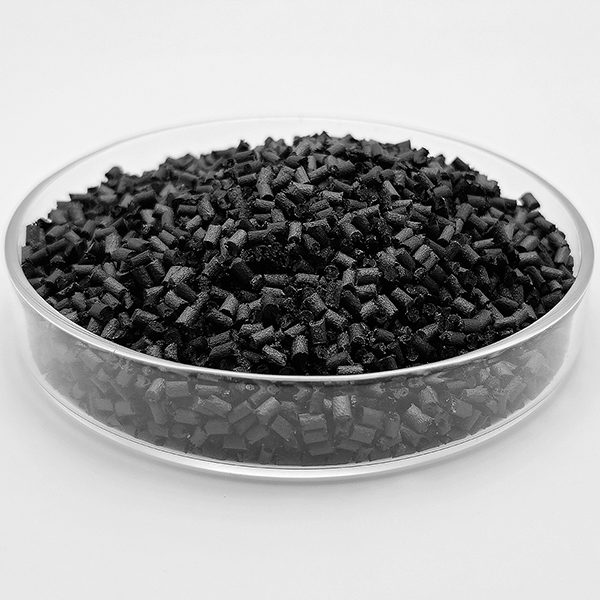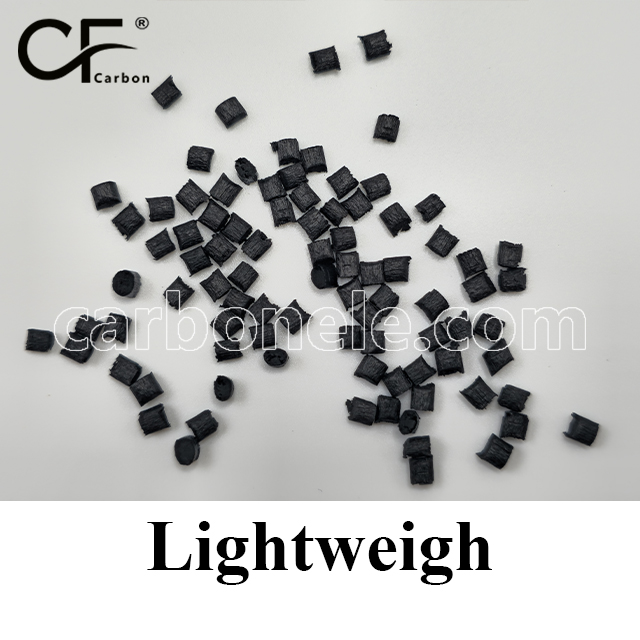
ABS CF10 Compound ABS 10%CF Thermoplastic Composites
ABS CF10 is a specialized filament designed to enhance the mechanical properties of ABS plastic through the addition of carbon fiber. It is favored in industries that require lightweight yet strong and durable parts, offering versatility in 3D printing applications where performance and reliability are paramount.
- Model: ABS-CF-BCA1
- Filler: 10% carbon fibers
- Manufacturer: Yes
- MOQ: 1000kgs
- Free Samples: 1-10kgs
- Port: Xiamen port, China
- OEM/ODM: Acceptable
What’s ABS CF10?
ABS CF10 refers to ABS (Acrylonitrile Butadiene Styrene) filament that is infused with 10% carbon fiber. This composite material combines the properties of ABS plastic with the reinforcing characteristics of carbon fiber. Here are some key points about ABS 10%CF:
1. **Material Composition**: ABS CF10 is primarily ABS plastic that has been mixed with 10% carbon fiber by weight. The carbon fiber is added to enhance the filament’s mechanical properties.
2. **Mechanical Properties**: The addition of carbon fiber significantly improves the stiffness and strength of ABS CF10 compared to standard ABS filament. It increases the modulus of elasticity, making the material more rigid and less prone to deformation under load.
3. **Strength and Durability**: ABS+CF10% exhibits higher tensile strength and impact resistance compared to pure ABS filament. This makes it suitable for applications where toughness and durability are required.
4. **Weight Reduction**: Carbon fiber is known for its lightweight properties. By incorporating carbon fiber into ABS, ABS 10% CF can achieve lighter weight parts with improved mechanical performance.
5. **Printability**: ABS CF10 can be printed using standard FDM (Fused Deposition Modeling) 3D printers that are capable of handling ABS filament. However, similar to other carbon fiber-infused filaments, it may require adjustments to printing parameters such as nozzle temperature and print speed.
6. **Applications**: Common applications for ABS CF10 include functional prototypes, tools, fixtures, and end-use parts in industries such as automotive, aerospace, robotics, and manufacturing. It is used where parts need to withstand mechanical stress, have improved dimensional stability, and benefit from the lightweight properties of carbon fiber.
7. **Surface Finish**: Parts printed with ABS CF 10 may have a matte black appearance due to the carbon fiber content. The surface finish can vary depending on print settings and post-processing techniques.
ABS CF10 is a composite filament that combines the versatility of ABS with the enhanced mechanical properties of carbon fiber. It offers a balance between strength, stiffness, and weight reduction, making it suitable for a wide range of functional and industrial applications in 3D printing.
Development trends of ABS CF10%
The development trends for ABS CF (Acrylonitrile Butadiene Styrene with Carbon Fiber) filament are influenced by advancements in materials science, additive manufacturing technologies, and evolving industrial applications. Here are some key trends in the development of ABS CF filament:
1. **Enhanced Mechanical Properties**: There is a continuous focus on improving the mechanical properties of ABS CF filaments, such as increasing tensile strength, stiffness, and impact resistance. This involves optimizing the carbon fiber content and distribution within the ABS matrix to achieve superior performance.
2. **Customization and Specialty Formulations**: Manufacturers are exploring the customization of ABS CF filaments to meet specific application requirements. This includes variations in carbon fiber content, additives for enhanced conductivity or other properties, and tailored formulations for different printing technologies and environments.
3. **Improved Printability**: Efforts are being made to enhance the printability of ABS CF filaments on standard FDM (Fused Deposition Modeling) printers. This includes developments in nozzle design, filament diameter consistency, and optimized printing parameters to reduce issues such as nozzle wear and warping.
4. **Broader Application Scope**: ABS 10% Carbon Fiber filament is expanding its application scope beyond traditional uses. Industries such as aerospace, automotive, medical devices, electronics, and consumer goods are increasingly adopting ABS CF for functional prototypes, tooling, jigs, fixtures, and end-use parts where strength, durability, and sometimes electrical conductivity are critical.
5. **Integration with Advanced Manufacturing Technologies**: ABS CF is being integrated with other advanced manufacturing technologies, such as multi-material printing and hybrid manufacturing processes. This enables the creation of complex parts with varying material properties in a single build, enhancing design flexibility and functionality.
6. **Sustainability and Recycling**: As with all materials, there is a growing emphasis on sustainability in ABS CF filament production and usage. Efforts are underway to incorporate recycled carbon fibers and develop methods for efficient recycling of printed parts, aligning with global trends towards environmentally friendly manufacturing practices.
7. **Quality Assurance and Standardization**: There is a push towards standardization of ABS CF filaments to ensure consistent quality, performance, and compatibility with different 3D printing systems. This involves establishing industry standards for filament specifications, testing methodologies, and certification processes.
the development trends for ABS CF filament are geared towards enhancing performance, expanding application possibilities, improving sustainability, and ensuring reliable and high-quality production for industrial and commercial use in additive manufacturing.
If you had any interest in this product, please do not hesitate to send an inquiry to us directly or email us with all your requirements. Thank you.
Learn more carbon fiber reinforced ABS compounds, please click here or visit our YouTube homepage to watch more videos on CFRTPs. Thank you.
Manufacturing Processes
ABS CF10 Manufacturing Processes involve several key steps. Firstly, the raw materials, including acrylonitrile butadiene styrene (ABS) and carbon fiber, are carefully selected and proportioned. Then, they are mixed thoroughly through specialized equipment. The mixture is heated to a specific temperature and molded into the desired shape using injection molding or extrusion techniques. Quality control checks are conducted throughout the process to ensure the final product meets the required standards. Sophisticated machinery and precise process control are crucial for the successful production of high-quality ABS CF10 products.

Modern Factory
The Modern Factory of Carbon Xiamen New Material is a state-of-the-art facility. It is equipped with advanced technologies and machinery for efficient production. The factory adheres to strict quality control measures to ensure the superior quality of its products. It also focuses on sustainability, minimizing environmental impact. Skilled workers and experienced engineers operate the production lines, ensuring smooth operations. The factory is committed to innovation, constantly exploring new materials and processes to stay at the forefront of the industry.

Advanced Laboratory Equipment
It encompasses a wide range of cutting-edge tools and instruments. High-precision analytical devices allow for detailed material composition analysis. Sophisticated testing machines assess mechanical and physical properties accurately. State-of-the-art imaging systems provide in-depth microstructure examination. This equipment not only enhances research capabilities but also ensures the quality and reliability of the developed materials. It is a crucial asset for Carbon Xiamen New Material in its pursuit of innovation and excellence.

Frequently Asked Questions
Carbon (Xiamen) New Material Co., Ltd. aims to provide buyers with "one-stop" worry-free high-quality services. Here you can find all information about carbon fiber engineering plastics. If you still have questions, please send us an email for consultation!
-
How can I contact the manufacturer of a product that interests me?
When you find a product you are interested in, you can contact the manufacturer directly by sending an email and we will get back to you as soon as possible.
-
How do I find the products that interest me?
All you need to do is enter the keyword, product name in the search window and press the Enter key on your keyboard. Your search results page will then be displayed. You can also search within the product category pages on the home page. Each category is divided into subcategories, allowing you to refine your search and find products that interest you.
-
Where will I find a buying guide?
Please contact our after-sales service directly and we will provide you with a comprehensive operating guide.
-
What are CF Reinforced Thermoplastic Composites?
CF Reinforced Thermoplastic Composites are materials where carbon fibers are incorporated into a thermoplastic matrix. They combine the strength and stiffness of carbon fibers with the processability and recyclability of thermoplastics. For instance, they are used in automotive parts like bumper beams.
-
What are the benefits of CF Reinforced Thermoplastic Composites over traditional composites?
The key benefits include faster production cycles, easier recyclability, and better impact resistance. They also offer design flexibility. An example is in the manufacturing of consumer electronics casings where complex shapes can be achieved more easily.
-
How are CF Reinforced Thermoplastic Composites processed?
Common processing methods include injection molding, extrusion, and compression molding. Injection molding is widely used for mass production. For example, in the production of small components for the medical industry.
-
What industries use CF Reinforced Thermoplastic Composites?
They are utilized in aerospace, automotive, medical, and sports equipment industries. In aerospace, they can be found in interior components. In the medical field, they might be used in prosthetics.
-
How does the carbon fiber content affect the properties of the composites?
Higher carbon fiber content generally leads to increased strength and stiffness but may reduce ductility. A moderate content is often balanced for specific applications. For example, a higher content might be preferred in structural parts of a race car.
-
What are the challenges in using CF Reinforced Thermoplastic Composites?
Challenges include higher material costs, complex processing equipment requirements, and ensuring uniform fiber dispersion. Issues with adhesion between the fibers and the matrix can also arise. An example is in achieving consistent quality in large-scale production.





























